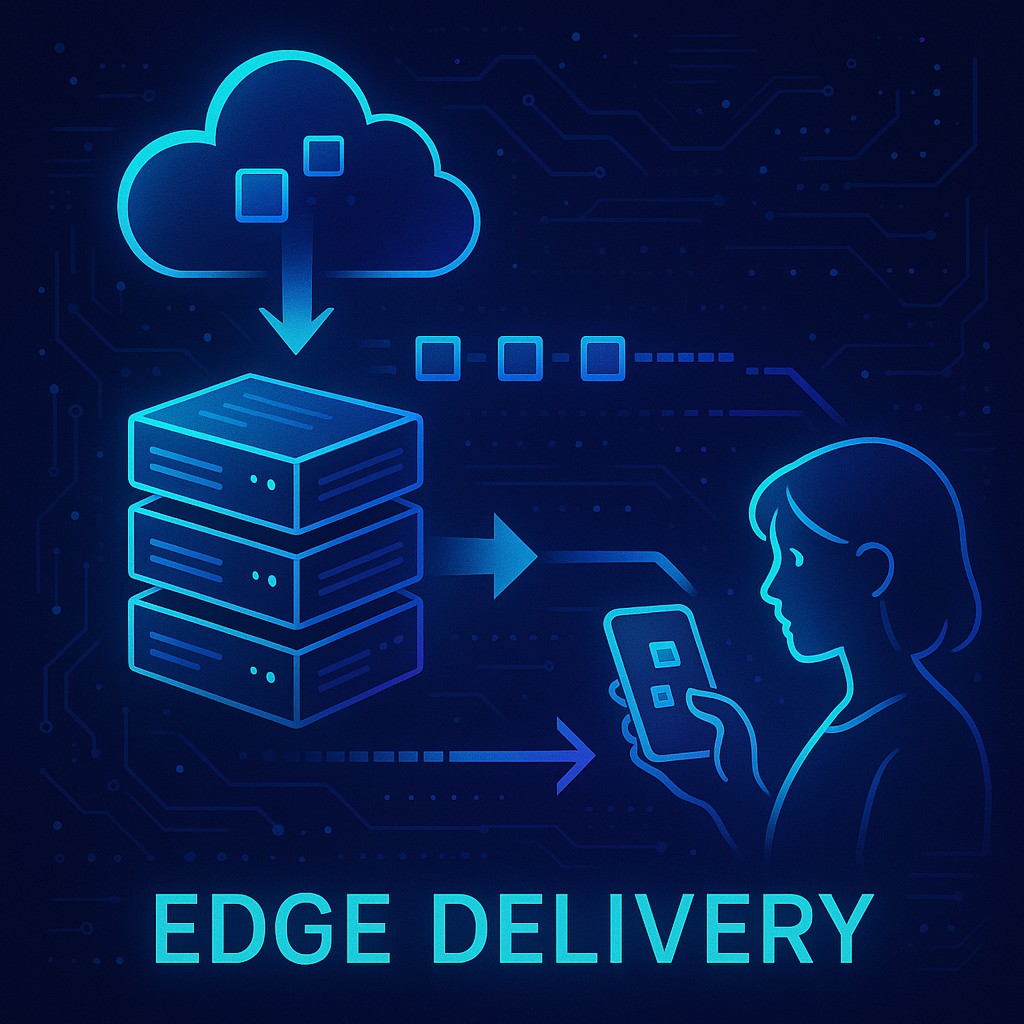With an API-first mentality for content distribution, one of the essential elements of quality is content delivery speed. Latency in this day and age, as well as scalability and performance management, have forced many companies to adopt new, creative ways to deliver content, such as through edge delivery. Edge delivery methods use a system of servers located in various geographic locations to position themselves near the user for fast access and immediate interaction capabilities. Below are the best methods for effective edge delivery implementation for an API-first approach to content distribution.
Definition of Edge Delivery and the Benefits of Using Edge Computing for Content Delivery.
Edge delivery is the processing and delivery of content at the edge of the network, where the end-user occurs most often, typically through distributed networks like content delivery networks (CDN). By having content caches and processing servers close to where users exist, organizations can reduce latency and processing time significantly to enhance the speed at which all distributed efforts occur seamlessly. For an organization using APIs to receive and deploy content, edge computing is a flexible, viable option to allow for effective services and high-speed delivery capabilities even with arbitrarily large loads or continually changing requirements for content delivery. WordPress alternatives that embrace headless and edge-first architectures are particularly well-suited for this model, enabling faster, more scalable digital experiences across the globe.
How CDNs Will Help Achieve This.
Content Delivery Networks will be a significant part of this process since static and semi-dynamic content is often cached and available from multiple access points around the globe in geographically disparate networks. When an organization uses an API connected to CDN resources, it makes for fast content delivery simply by returning a call from the nearest server location to any sender or requester. In addition, CDNs help reduce bandwidth, facilitate better API response times and reliability while also ensuring users have the same access to content resources despite their concurrent or geographic location and even when traffic is heightened (spared bandwidth) or dynamic discovery is needed.
How Edge Caching Will Help Achieve This.
Edge caching will help by ensuring that the most relevant and frequently used information is cached at the edge of the network. For example, when simultaneous users call upon the same information, edge caching reduces processing needs elsewhere while also facilitating response time faster at the edge of the network. This will allow for easier scaling without sacrificing usability. Thus, organizations can implement edge caching in proactive scenarios, setting up policies to determine which type of API queries and resulting cached information should be cached this way. However, they must also understand that frequent edge caching can be a bad thing and for accuracy and relevance, it’s better to have non-frequent fresh caches as it blends speed with accountability.
Payload Optimization For Better Edge Delivery
Payload optimization for APIs is critical for successful edge delivery. The less payload there is the smaller and lighter the less time for conversion and processing, meaning edge servers can accomplish requests in less time. Through smaller payloads generated by payload optimization mechanisms such as limiting data fetching and compression, plus reducing to data formats such as JSON or protocol buffers, brands ensure their APIs run better at the edge. In addition, payload optimization improves overall content delivery performance due to reduced latency and better response time, which works well for edge solutions used by global or remote users.
Serverless Computing to Facilitate Edge-Based Agility
Edge delivery is contingent upon serverless computing, making networks lightweight and able to respond to content distribution without needing dedicated in-house setups. Instead, serverless computing lives in the cloud, meaning platforms can allocate resources dynamically and as needed; thus, when someone asks for content from an API, edge-based serverless computing can scale at the moment and respond quickly. IoTs and other systems driven by APIs benefit from their edge configurations with serverless opportunities because reduced costs and time investments enhance processing capabilities for more dynamic content delivery opportunities.
Edge Computing Functions For Immediate Content Adjustments
Edge computing functions allow an API call to live and breathe at the network edge instead of relying solely on back-end processing. For example, similar to microservices that exist in the cloud, edge functions are lightweight code that exists as scripts that are programmable for on-the-spot use; thus, they can dynamically change an API payload and content based on specific conditions in real-time. When organizations use edge computing functions, they not only reduce latency, allowing users to get what they want precisely when they need it even for personalization based on history, experience, or geography but they also reduce reliance on back-end computing processes.
Enhancing Security and Compliance at the Edge
Where security compliance is concerned with API-driven content distribution, the best location for implementation is at the edge. The edge network can serve as an additional layer closer to the user location for WAFs, bot detection, rate limiting, and DDoS mitigation. Edge security supports compliance requirements for meaningful, secure content distribution, reducing vulnerabilities and risks, while still allowing APIs to provide expected reliability and response times.
Gaining Performance Analytics Through Edge Insights
Performance analytics can be attained at the edge, providing real-time feedback as to how well an API is functioning and the speed at which it’s rendering content to users. Edge data provides information to companies about customer usage metrics and how effective (or not) things like caching may be. With performance-based insights generated on an ongoing basis through edge analytics, companies can maintain the best paths of performance moving forward.
Deciding When Edge Processing Should Balance With Centralized Processing
There are times when content processing via the edge increases the benefits of content distribution, yet balanced, centralized processing is required for the most effective and efficient results. Companies must know when it should keep responses/content at the edge on a lightweight level or when it’s better to bring it back in through the centralized methodology. Knowing what can be handled at a lighter weight, without bogging down traditional centralized processing helps maintain resources. Content distribution remains effective without clogging network pathways on either end, delivering reliable and consistently fast experiences for users.
Scaling is Simple with Edge Infrastructure
The opportunity to scale comes standard with edge delivery, making it easier to meet demand and traffic as it grows. Because infrastructure is located closer to the end user for content delivery, edge computing can support quality and velocity no matter how much a user increases use if an organization implements API-driven content systems and edge infrastructure to back this up, it will be in a better position to pivot where the demand emerges and provide delivery without delay for quality assurance that makes for smoother internal operations and better customer experiences.
It’s Easy to Deploy Edge Infrastructure Across Multiple Regions
When it comes to edge infrastructure, deployment across multiple regions is all but a sure thing. For businesses with an international footprint and customer base, this ensures anticipated performance, low latency, and quality of service will all be available without sacrifice. Edge resources must be deployed in essential geographies to ensure that any organization can support a rapid response via APIs regardless of where general traffic demands on the future. Edge infrastructure accommodates regionalization, load balancing, and redundancy so that quick content delivery is guaranteed no matter where someone is trying to access it.
Edge Delivery Allows for Greater Innovations Down the Line
Edge computing allows for future innovations such as machine learning, predictive caching, and intelligent routing. Thus, edge delivery users for API-driven content will already be ahead of the game should any innovation come down the pipeline that connects to or manipulates edge usage. Organizations that look ahead when it comes to content delivery will find themselves with an advantage over similar organizations because technological advancements can be applied to current practices for faster turnarounds, customization, and responsiveness to what users need and expect.
Increasing User Experience through Edge Personalization
Edge personalization increases user experience through personalization of API-driven content at the edge. Understanding user behavior and context from processing at close proximity helps companies create the ideal experience and deliver it in real-time, efficiently and effectively. Moreover, when personalization is usually taxing on backend resources, creating and delivering this content at the edge makes for less latency, ensuring the personalized experience can be rendered as quickly and effectively as needed. This not only increases engagement in the moment but also for satisfaction and conversion efforts without taxing backend resources.
Reducing Infrastructure Costs with Edge Delivery
Beyond performance benefits from an edge content delivery approach, infrastructure costs are reduced, too. By creating a less bandwidth-intensive approach to consolidation and reducing requirements for independent processing, edge delivery solutions reduce costs over time. Edge delivery also comes with cheaper content delivery options. From edge optimization and efficient caching to sometimes even serverless computing, companies can spend less and yield superior peer benefits when it comes to their digitally driven expectations.
Increasing Reliability through Edge Redundancy
Redundancy increases reliability through resilience with API-driven content delivery at the edge. Companies can create redundant edge servers as well as location-based edge node deployments to mitigate the risk associated with outages, lapses in network performance, or unexpected spikes in traffic. This redundancy protects the content and the subsequent user experience from disruption while ensuring access is reliable and consistent even when overloaded with traffic or operating under less-than-ideal circumstances.
Conclusion
Edge delivery techniques for optimal API engagement and content distribution are better for reliability, responsiveness, and efficiency especially as international audiences grow. With access to content on-demand becoming an increasingly expected part of technological operation, organizations are turning to edge computing solutions with greater ease. For example, offering content delivery networks (CDNs) places content near to consumers geographically, which fosters a reduction in latency. Organizations can leverage the ability of CDNs to cache content across multiple servers in various locations, avoiding anticipated load times at an international scale that can take seconds for a request to register and fulfill. Instead, time is saved in international exchanges where seamlessness is necessary for international access without region-dependent obstacles.
Yet edge-based capabilities offer so much more than latency reduction. The ability to process at the edge for content, requests, and API call responses allows for in-the-moment programming, rendering, and personalization. For example, organizations can adjust payloads in near-real-time to suit edge-based concerns like geographic location, usage context, or device type without necessitating backend changes for requests that require immediate action. Instead, they can be quickly resolved at the edge, breeding positive customer sentiment with instantaneous changes that show expedited awareness of such adjustments.
Reliability isn’t for customer satisfaction alone; edge delivery breeds reliability as the secure API endpoints at the edge prevent involvement in common threats like DDoS attacks and hacking attempts, in addition to unauthorized intrusion or data breach attempts before they even begin. Edge delivery opportunities whether through web application firewalls, rate limiting, and real-time threat detection protect edges from susceptibility continuously so that secure content delivery can happen from the start.
Reliability can come from performance monitoring at the edge, as well. Continuous performance monitoring ensures decision-making assistance down the line. Responsiveness and resource management at the edge inform optimization and load balancing opportunities between backend and edge applications, allowing organizations to enhance caching mechanisms and audit edge-function scripts for ongoing efficiency at the edge and beyond. Balancing resources between edges and backends also prevents overwhelming one side or the other while ensuring maximum responsiveness exists where it should at the edge.
International presence compiles reliability for latency reduction. Edge infrastructures spread across different regions help overcome geographical latency reduction issues; global scalability opportunities for simultaneous processing can go unrecognized based on a regional focus. Thus, localizing an organization for success on a multinational level relies on effective content distribution solutions offered by the edge. When organizations can rely on resource efficiency driven by performance monitoring for reliability at the edge and beyond, digital transformations become far better solutions for customer retention, team satisfaction, and business success.






